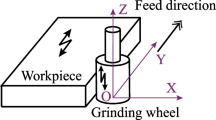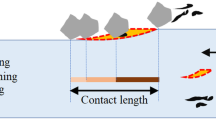Abstract
Based on the random distribution characteristic of abrasive grains for the grinding wheel circumferential surface during the manufacturing process, considering the grinding parameters and deflection parameters comprehensively, a randomly deflected truncated cone shape single abrasive grain cutting simulation model was established. Then, studying its cutting mechanism, i.e., the trajectory length value by numerical method and formula method was compared, the consequence indicates that the error is extremely small; this demonstrates the accuracy of the numerical method. The calculation and analysis of the workpiece cutting surface topography and the undeformed chip shape were carried out; it shows that the cutting surface topography and the undeformed chip shape are coincident. And the calculation results of the model were compared to verify. The influence laws of each grinding process parameter on the material removal volume (MRV) and material removal rate (MRR) were investigated; the results display that the grinding method affects the changing pattern of MRV and MRR; when the grinding method was up-grinding, a high wheel speed or a small wheel diameter is able to enhance the MRR; the MRV and MRR are increments with the increasing workpiece feed speed or abrasive grain cutting depth; and the MRV and MRR decrease with the raising of the absolute value of single abrasive grain deflection angle. The situation is a similar or opposite trend in down grinding. This work can provide a theoretical reference for the selection and optimization of parameters and further lay a foundation for the research in the grinding mechanism of the grinding wheel.


















Similar content being viewed by others
Availability of data and material
All data generated or analyzed during this study are included in this published article.
References
Sun C, Hong Y, Xiu S, Yao Y (2021) Grain refinement mechanism of metamorphic layers by abrasive grinding hardening. J Manuf Processes 69:125–141. https://doi.org/10.1016/j.jmapro.2021.07.040
Fan Z, Tian Y, Zhou Q, Shi C (2020) A magnetic shear thickening media in magnetic field-assisted surface finishing. Proc Inst Mech Eng B J Eng Manuf 234(6–7):1069–1072. https://doi.org/10.1177/0954405419896119
Agarwal S, Rao PV (2010) Modeling and prediction of surface roughness in ceramic grinding. Int J Mach Tools Manuf 50:1065–1076. https://doi.org/10.1016/j.ijmachtools.2010.08.009
Wang Y, Xiu S, Zhang S (2021) Microstructure evolution and crystallographic slip modes during grind hardening in TC21 titanium alloy. Surf Coat Technol 417:127211. https://doi.org/10.1016/j.surfcoat.2021.127211
Oliveira JFG, Silva EJ, Gomes JJF, Klocke F, Friedrich D (2005) Analysis of grinding strategies applied to crankshaft manufacturing. CIRP Ann - Manuf Technol 54:269–272. https://doi.org/10.1016/S0007-8506(07)60100-0
Stephenson DJ, Sun X, Zervos C (2006) A study on ELID ultra precision grinding of optical glass with acoustic emission. Int J Mach Tools Manuf 46:1053–1063. https://doi.org/10.1016/j.ijmachtools.2005.08.013
Caggiano A, Teti R (2013) CBN grinding performance improvement in aircraft engine components manufacture. Procedia CIRP 9:109–114. https://doi.org/10.1016/j.procir.2013.06.177
Dai C, Yu T, Ding W, Xu J, Yin Z, Li H (2019) Single diamond grain cutting-edges morphology effect on grinding mechanism of Inconel. Precis Eng 55:119–126. https://doi.org/10.1016/j.precisioneng.2018.08.017
Ren J, Hao M, Lv M, Wang S, Zhu B (2018) Molecular dynamics research on ultra-high-speed grinding mechanism of monocrystalline nickel. Appl Surf Sci 455:629–634. https://doi.org/10.1016/j.apsusc.2018.06.042
Anderson D, Warkentin A, Bauer R (2012) Comparison of spherical and truncated cone geometries for single abrasive-grain cutting. J Mater Process Tech 212(9):1946–1953. https://doi.org/10.1016/j.jmatprotec.2012.04.021
Gu P, Zhu C, Tao Z, Yu Y (2020) A grinding force prediction model for SiCp/Al composite based on single-abrasive-grain grinding. Int J Adv Manuf Technol 109:1563–1581. https://doi.org/10.1007/s00170-020-05638-7
Yin J, Xu J, Ding W, Su H (2012) Effects of grinding speed on the material removal mechanism in single grain grinding of SiCf/SiC ceramic matrix composite. Ceram Int 47(9):12795–12802. https://doi.org/10.1016/j.ceramint.2021.01.140
Tian Y, Li L, Han J, Fan Z, Liu K (2020) Development of novel high-shear and low-pressure grinding tool with flexible composite. Mater Manuf Process 36(4):479–487. https://doi.org/10.1080/10426914.2020.1843673
Malkin S (2008) Grinding technology: theory and application of machining with abrasives. Industrial Press Inc., New York
Tian Y, Li L, Liu B, Han J, Fan Z (2020) Experimental investigation on high-shear and low-pressure grinding process for Inconel718 superalloy. Int J Adv Manuf Technol 107(7–8):3425–3435. https://doi.org/10.1007/s00170-020-05284-z
Chen X, Rowe WB (2014) Analysis and simulation of the grinding process. Part I: generation of the grinding wheel surface. Eur Heart J 35:2264–2265. https://doi.org/10.1093/eurheartj/ehu271
Zhang Y, Li C, Ji H, Yang X, Yang M, Jia D, Zhang X, Li R, Wang J (2017) Analysis of grinding mechanics and improved predictive force model based on material-removal and plastic-stacking mechanisms. Int J Mach Tools Manuf 122:81–97. https://doi.org/10.1016/j.ijmachtools.2017.06.002
Aurich JC, Kirsch B (2012) Kinematic simulation of high-performance grinding for analysis of chip parameters of single grains. CIRP J Manuf Sci Technol 5:164–174. https://doi.org/10.1016/j.cirpj.2012.07.004
Bhushan B (2013) Introduction to tribology. Wiley
Anandita S, Mote RG, Singh R (2017) Stochastic analysis of microgrinding tool topography and its role in surface generation. J Manuf Sci Eng Trans ASME 139:1–14. https://doi.org/10.1115/1.4038056
Koshy P, Jain VK, Lal GK (1997) Stochastic simulation approach to modelling diamond wheel topography. Int J Mach Tools Manuf 37:751–761. https://doi.org/10.1016/S0890-6955(96)00086-7
Zhang X, Yao B, Feng W, Shen Z, Wang M (2015) Modeling of a virtual grinding wheel based on random distribution of multi-grains and simulation of machine-process interaction. J Zhejiang Univ Sci A 16:874–884. https://doi.org/10.1631/jzus.A1400316
Cooper WL, Lavine AS (2001) Grinding process size effect and kinematics numerical analysis 122:59–69
Jiang J, Sun S, Wang D, Y Y, Liu X, (2020) Surface texture formation mechanism based on the ultrasonic vibration-assisted grinding process. Int J Mach Tool Manuf 156:0890–6955. https://doi.org/10.1016/j.ijmachtools.2020.103595
Wang C, Chen J, Fang Q, Liu F, Liu Y (2016) Study on brittle material removal in the grinding process utilizing theoretical analysis and numerical simulation. Int J Adv Manuf Technol 87:2603–2614. https://doi.org/10.1007/s00170-016-8647-8
Funding
The work was supported by the National Natural Science Foundation of China (Grant No. 51605240 and No. 51705272), the National Science Foundation for Post-doctoral Scientists of China (Grant No. 2018M632643), and the Taishan Scholar Project of Shandong Province (Grant No. ts201511038).
Author information
Authors and Affiliations
Contributions
Conceptualization, Jingliang Jiang; methodology, Dexiang Wang and Shufeng Sun; investigation, Lansheng Zhang; data curation, Lansheng Zhang; writing—original draft preparation, Lansheng Zhang; writing—review and editing, Dexiang Wang; supervision, Jingliang Jiang.
Corresponding author
Ethics declarations
Ethics approval
Not applicable.
Consent to participate
Not applicable.
Consent for publication
All authors have read and agreed to the published version of the manuscript.
Competing interests
The authors declare no competing interests.
Additional information
Publisher's Note
Springer Nature remains neutral with regard to jurisdictional claims in published maps and institutional affiliations.
Rights and permissions
About this article
Cite this article
Zhang, L., Jiang, J., Wang, D. et al. Study on the cutting mechanism of randomly deflected truncated cone shape single abrasive grain. Int J Adv Manuf Technol 120, 1909–1928 (2022). https://doi.org/10.1007/s00170-022-08824-x
Received:
Accepted:
Published:
Issue Date:
DOI: https://doi.org/10.1007/s00170-022-08824-x




